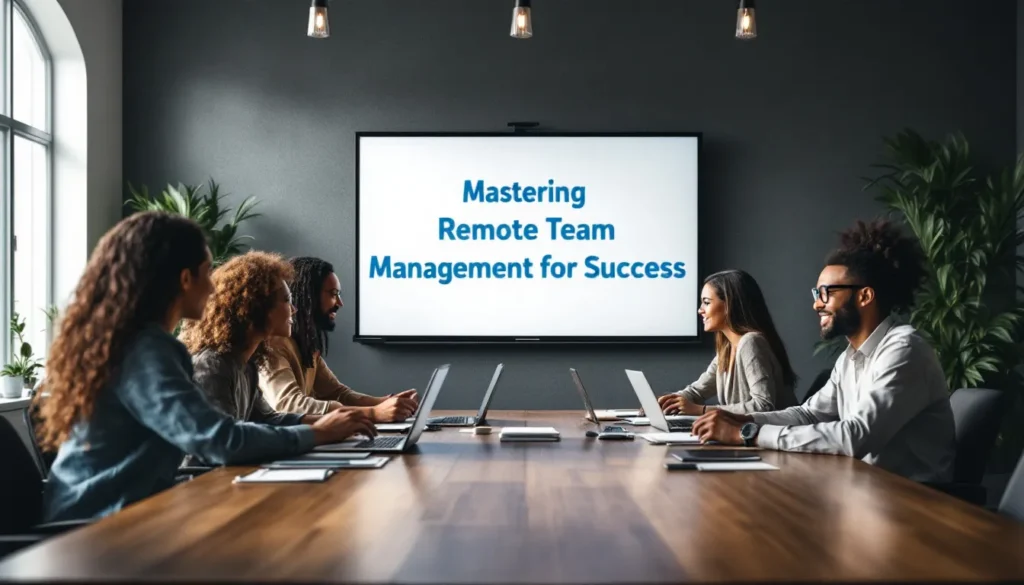Managing remote teams effectively requires a combination of strategic approaches, reliable tools, and a commitment to fostering a collaborative and secure work environment. Explore the dynamics of effectively managing remote teams in today’s digital landscape and understand the key components necessary for a seamless operation.
Establish Clear Communication Channels
- Use a Mix of Tools: Implement a variety of communication tools such as email, instant messaging apps (Slack, Microsoft Teams), video conferencing (Zoom), and project management software to ensure seamless communication.
- Regular Check-ins: Hold regular virtual meetings and updates to maintain transparency and keep the team connected.
Set Clear Expectations and Goals
- Define Deliverables and Deadlines: Clearly outline expectations, goals, roles, and performance metrics to keep employees focused and accountable.
- Regularly Review and Adjust: Frequent reviews and adjustments are necessary to align with evolving business needs.
Time Zone Management
Coordinating across different time zones can be challenging. Implement strategies such as rotating meeting times or using shared calendars to maximize productivity while respecting everyone’s availability.
Foster a Collaborative Culture
- Use Collaboration Tools: Utilize tools like shared documents, virtual whiteboards, and team chat rooms to facilitate group work.
- Team-Building Activities: Organize virtual coffee breaks and team-building activities to strengthen relationships and build trust.
Prioritize Employee Well-Being
- Promote Healthy Work-Life Balance: Encourage regular breaks and flexible working hours to maintain a healthy work-life balance.
- Mental Health Resources: Provide access to mental health resources and support to ensure the well-being of remote employees.
Invest in the Right Tools and Technology
- Reliable Hardware and Software: Invest in reliable hardware, software, and internet connections to support remote work.
- Project Management Tools: Use tools like Trello, Asana, and Monday.com to streamline workflows and keep track of tasks.
Performance Management
Monitoring and enhancing team performance is essential in a remote environment. Here are strategies that can elevate productivity:
Goal Setting
Utilizing frameworks like OKRs (Objectives and Key Results) or SMART goals can provide direction and motivate team members. Clear goals create a common purpose and align efforts across the team.
Regular Check-ins
Establishing frequent one-on-one and team meetings allows for consistent progress monitoring and problem-solving, encouraging open communication and addressing issues before they escalate.
Feedback Mechanisms
Creating feedback loops is vital for continuous improvement and development. Encourage team members to share their thoughts on processes and performance, fostering a culture of growth.
Fostering Team Culture
A strong team culture can enhance morale and engagement, even when working remotely. Here are ways to enhance team spirit:
Inclusion and Diversity
Valuing diverse perspectives within your team contributes to a richer work environment. Encourage everyone to voice their ideas and opinions to make all team members feel valued.
Recognition and Rewards
Acknowledging achievements and contributions is essential to keeping team members motivated. Implement recognition programs or shout-outs during meetings to celebrate successes.
Technology and Security
In today’s digital era, leveraging technology while ensuring security is paramount. Here’s how to address this critical aspect:
Secure Platforms
Implementing secure technology solutions for data protection and privacy is crucial. Ensure that all communication and collaboration tools are compliant and secure to protect sensitive information.
Troubleshooting Support
Providing IT support to solve tech issues promptly ensures that the team can maintain productivity without unnecessary disruptions. Have a system in place for quick access to technical help.
Conclusion
In summary, mastering remote team management requires a focus on structure, communication, and culture. By implementing the strategies outlined above, you will be well on your way to leading a successful remote team that thrives in today’s digital landscape.
FAQs
What are the best practices for managing remote teams?
Set clear expectations, use structured communication, and establish regular check-ins. Provide the right tools, encourage transparency, and foster a strong remote work culture.
How can I improve communication with remote team members?
Use a mix of synchronous (video calls, chat) and asynchronous (emails, recorded updates) communication. Set clear guidelines on response times and use collaboration tools to keep everyone aligned.
What tools are suggested for managing a remote workforce?
Slack and Microsoft Teams for communication, Zoom for meetings, Asana or Trello for task management, and Notion or Google Drive for documentation. Time tracking tools like Toggl can help with accountability.
How do you handle time zone differences in remote teams?
Use overlapping work hours for critical meetings and rely on asynchronous updates for flexibility. Clearly document tasks and use scheduling tools like World Time Buddy to coordinate effectively.
What strategies are effective for boosting remote team morale?
Regular virtual team-building activities, recognition programs, and open communication help maintain engagement. Encouraging social interaction and offering wellness initiatives also boost morale.
How can I ensure productivity in a remote team?
Set clear goals, track progress with project management tools, and encourage regular check-ins. Foster a results-oriented culture instead of micromanaging hours worked.
What are common challenges in managing remote teams and how can they be addressed?
Challenges include miscommunication, isolation, and lack of accountability. Address them by setting clear expectations, promoting team bonding, and using transparency-driven tools for collaboration.





